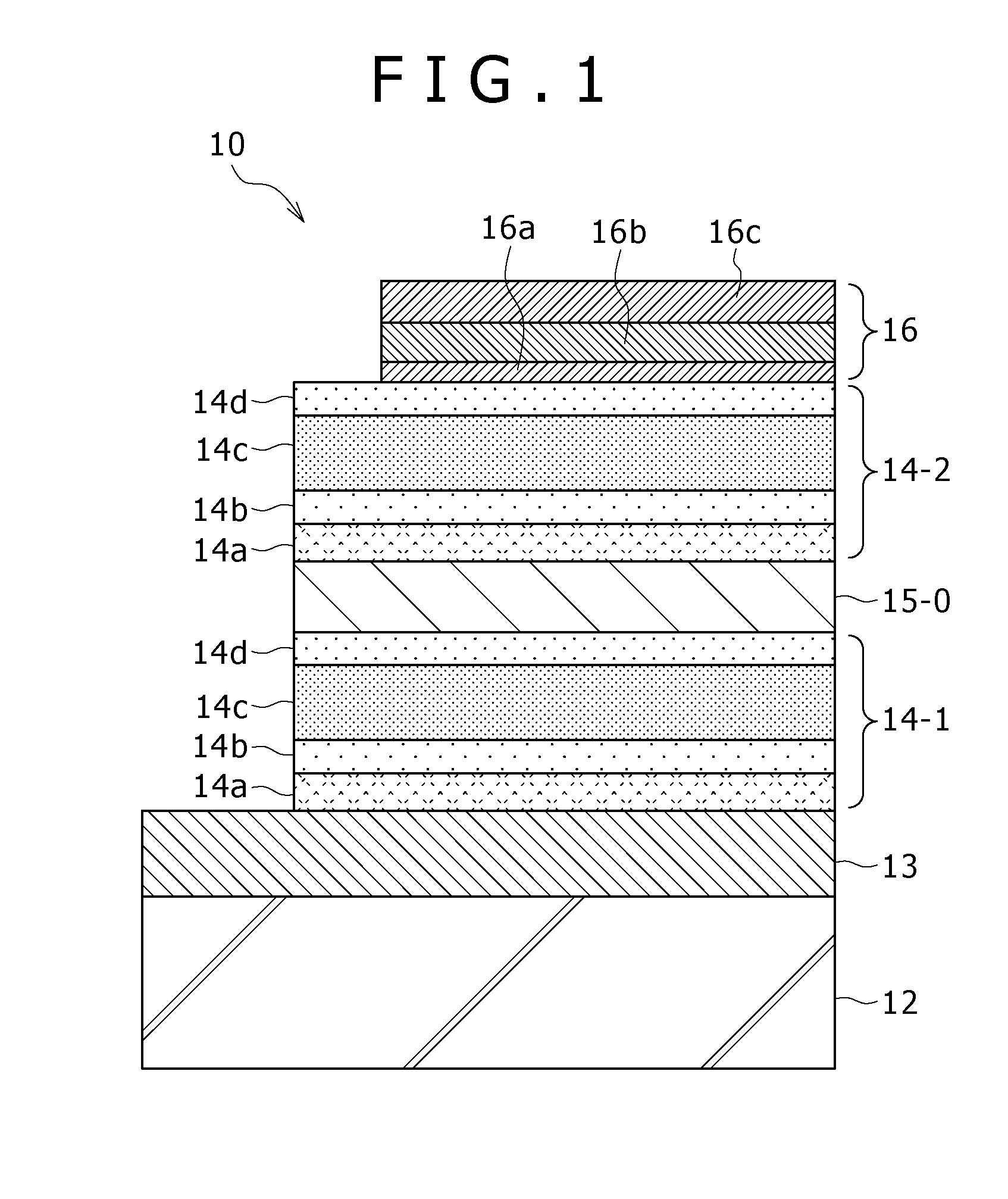Display device
a display device and display technology, applied in thermoelectric devices, identification means, instruments, etc., can solve the problems of difficult realization of next-generation television sets, limited application, and bcp is, therefore, hardly usable, and achieve the effects of improving the efficiency of charge injection into each light-emitting unit, improving lifetime characteristics, and improving brightness
- Summary
- Abstract
- Description
- Claims
- Application Information
AI Technical Summary
Benefits of technology
Problems solved by technology
Method used
Image
Examples
first embodiment
[0034]FIG. 1 is a cross-sectional view showing one construction example of a display device according to the first embodiment. The display device 10 shown in this drawing is a stacked display device 10 composed of light-emitting units stacked one over the other, and is provided with an anode 13 arranged on a substrate 12, plural light-emitting units 14-1,14-2, . . . (two in this embodiment) stacked together and arranged on the substrate 13, a charge generation layer 15-0 arranged between these light-emitting units 14-1,14-2, and a cathode 16 arranged as a top layer on the light-emitting unit 14-2.
[0035] A description will hereinafter be made of the construction of a surface-emitting display device that light produced upon recombination of holes, which have been injected from the anode 13, and electrons, which have been generated in the charge generation layer 15-0, within the light-emitting unit 14-1 and light produced upon recombination of electrons, which have been injected concu...
second embodiment
[0066]FIG. 2 is a cross-sectional view showing one construction example of a display device according to the second embodiment. A display device 11 shown in this drawing is different in the construction of a charge generation layer 15 from the display device 10 described with reference to FIG. 1, and in the remaining construction, they are supposed to be similar to each other. Centering around the charge generation layer 15, the construction of the display device 11 according to the second embodiment will hereinafter be described in detail.
[0067] Specifically, in the display device 11 according to the second embodiment, the charge generation layer 15 arranged between the light-emitting unit 14-1 and the light-emitting unit 14-2 has been formed using an oxide which contains at least one (at least one element) of alkali metals and alkaline earth metals. This charge generation layer 15 has a construction that an interfacial layer 15a and an intrinsic charge generation layer 15b are st...
third embodiment
[0087]FIG. 3 is a cross-sectional view showing one construction example of a display device according to the third embodiment. A display device 11′ shown in this drawing is different in the construction of a charge generation layer 15′ from the display device 10 described with reference to FIG. 1, and in the remaining construction, they are supposed to be similar to each other. Centering around the charge generation layer 15′, the construction of the display device 11′ according to the third embodiment will hereinafter be described in detail.
[0088] Specifically, the charge generation layer 15′ in the display device 11′ according to the third embodiment has a construction that an interfacial layer 15a′ and an intrinsic charge generation layer 15b are stacked together in this order from the side of the anode 13. Because this interfacial layer 15a′ acts as a cathode for the light-emitting unit 14-1 arranged in contact with the anode 13 as in the second embodiment, this interfacial lay...
PUM
| Property | Measurement | Unit |
|---|---|---|
| thickness | aaaaa | aaaaa |
| thickness | aaaaa | aaaaa |
| thickness | aaaaa | aaaaa |
Abstract
Description
Claims
Application Information
 Login to View More
Login to View More - R&D
- Intellectual Property
- Life Sciences
- Materials
- Tech Scout
- Unparalleled Data Quality
- Higher Quality Content
- 60% Fewer Hallucinations
Browse by: Latest US Patents, China's latest patents, Technical Efficacy Thesaurus, Application Domain, Technology Topic, Popular Technical Reports.
© 2025 PatSnap. All rights reserved.Legal|Privacy policy|Modern Slavery Act Transparency Statement|Sitemap|About US| Contact US: help@patsnap.com



